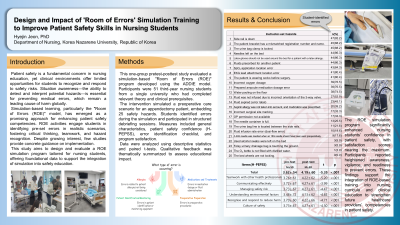Education
(62) Design and Impact of 'Room of Errors' Simulation Training to Improve Patient Safety Skills in Nursing Students
Thursday, June 19, 2025
5:00 PM - 6:30 PM MST
Location: Exhibit Hall


Hyejin Jeon, PhD
Associate professor
Korea Nazarene University
Chonan Si, Ch'ungch'ong-namdo, Republic of Korea
Lead Author(s)
Abstract: This study aimed to develop a Room of Errors (ROE) simulation program to enhance nursing students' competencies in patient safety and evaluate its effectiveness. Designed as a descriptive methodological study, it focused on how simulation-based education could improve students' patient safety skills. During the simulation, nursing students identified preoperative errors in a case involving an appendicitis patient. To assess effectiveness, a one-group pretest-posttest design measured changes in patient safety confidence before and after participation in the program. Results showed high satisfaction with the ROE program, scoring 4.90 ± 0.36 on a 5-point Likert scale. Confidence in patient safety (measured with the H-PEPSS scale) significantly increased, with scores improving from 3.62 ± 0.538 to 4.19 ± 0.595. Participants provided positive feedback, reporting greater awareness, confidence, and vigilance in error prevention. These findings suggest that ROE-based simulation programs effectively enhance patient safety skills and are valuable tools for both nursing students and healthcare professionals aiming to strengthen their competencies in clinical safety.
Please include a short summary of your presentation that highlights why an attendee would want to view your poster.: This study developed a Room of Errors (ROE) simulation to enhance nursing students' patient safety skills, aiming to boost engagement and enjoyment in the learning process. Using a pretest-posttest design, results showed high satisfaction and a significant increase in safety confidence. Participants reported improved awareness and vigilance in preventing errors, underscoring ROE's value in strengthening clinical safety competencies.
Please include a short summary of your presentation that highlights why an attendee would want to view your poster.: This study developed a Room of Errors (ROE) simulation to enhance nursing students' patient safety skills, aiming to boost engagement and enjoyment in the learning process. Using a pretest-posttest design, results showed high satisfaction and a significant increase in safety confidence. Participants reported improved awareness and vigilance in preventing errors, underscoring ROE's value in strengthening clinical safety competencies.
Learning Objectives:
- Upon completion, participants will be able to identify at least three common preoperative safety errors in a simulated patient scenario focused on appendicitis.
- Upon completion, participants will be able to demonstrate increased confidence in their patient safety skills, as measured by a post-simulation confidence survey.
- Upon completion, participants will be able to reflect on their experience and describe two ways in which the ROE simulation increased their engagement in patient safety protocols.
